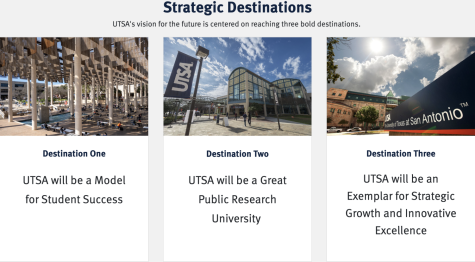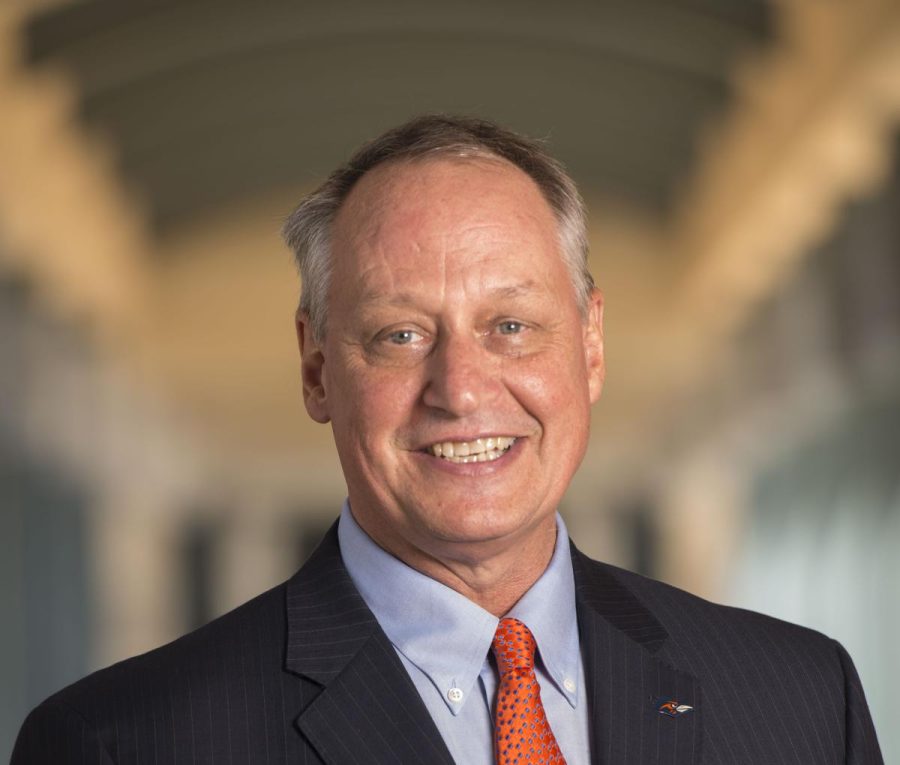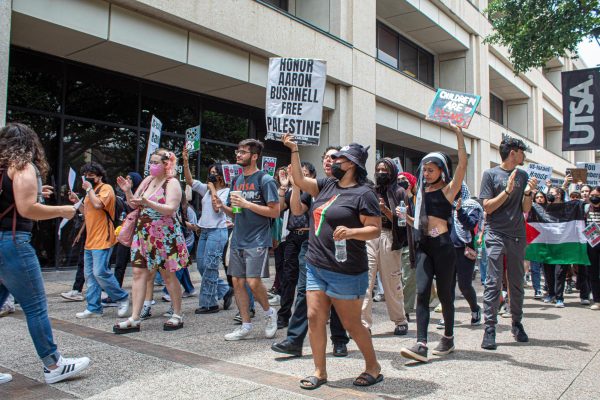A vision for the future: UTSA hosts town hall on ten-year strategic plan refresh
President Eighmy spoke about UTSA’s goals for the next five years of its strategic plan.
December 4, 2022
UTSA President Taylor Eighmy and Senior Director of Strategic Initiatives Dr. Lisa Jasinski hosted a town hall to discuss a refresher on the university’s strategic plan that was launched in 2018. Topics such as gentrification, inclusive excellence and logistics were discussed among questions from the audience.
On Monday, Nov. 28, at the downtown campus’ Buena Vista Theater, the conversation started around an update to the website for all of the current and past information regarding UTSA’s strategic plan. The site hosts information regarding UTSA strategic destinations — goals in place to track UTSA’s bold vision status — and the various initiative categories. In addition, a new frequently asked questions section helps bring people up to speed on the plan.
What is a strategic plan?
The process began in 2017 and was fully adopted by early 2018. In Eighmy’s words, adapting a strategic plan is an honored process. He discussed the reasoning for selecting a 10-year plan for UTSA.
“What’s special about it is [that] a 10-year period allows you to look over the horizon and think about the future, plan for the future if you can [and] at the same time, accommodate the annual review process that happens for the institution.”
Eighmy further described that a refresher typically occurs around the halfway point of the plan.
“Typically, in a 10-year strategic plan, you would stop at year five and reassess if it was working or not,” Eighmy said. “Typically, what happens is that UT System and the [Board of Regents] ask for an update for a 10-year strategic plan at year’s end [and] we’re in the process of doing that right now.”
Eighmy touted the strategic plan as being community-focused and transparent. Additionally, he praised the hybrid modalities that the university has adopted since the onset of the COVID-19 pandemic.
“What [is] special is that this is a very community-engaged process, [a] very transparent process,” Eighmy said. “We are building this to really take advantage of some of the hybrid technologies we have learned and acquired post-pandemic to be able to take our story out about the strategic plan and refresh process across the institution.”
Eighmy thanked the members of the Strategic Planning Refresh Steering Committee in attendance. The team — led by Provost Kimberley Andrews Espy — includes a multi-disciplinary committee that comes from across campus, including members of UTSA’s faculty and staff senates, department chairs council and the student government association, among others. A complete list of the committee members can be found here.
Strategic initiatives
A pillar of Eighmy’s leadership is the concept of experiential learning — a classroom-to-career initiative intrinsic to UTSA’s culture and student success. Eighmy spoke about why the concept draws students in and what the initiative will look like in the next five years.
“I think that is one of the foundational components of a UTSA education,” Eighmy said. “ We had to submit a 10-year plan for quality enhancement about our academic enterprise and its focus on classroom-to-career. We have elected to have [experiential learning] be one of the big, big differentiators for a UTSA undergraduate education … the fact that we are making it such an institution-wide component of the learning experience is unique to UTSA here in Texas.”
In looking to the future, Eighmy hopes to find ways to better describe experiential learning efforts and its relationship with learning outcomes, social mobility and return on investment.
Inclusive excellence is another critical initiative at UTSA. Eighmy spoke on the efforts underway to retain a diverse group of dedicated faculty and staff.
“I think it’s important to turn our attention to a couple of things,” Eighmy said. “One is who we are as an institution, that we are a Hispanic Serving [really a] Hispanic Thriving institution. Our entire purpose when we were created as a university back in 1969 was to really serve our community.”
Eighmy further explained the “moral imperative” UTSA has to the greater San Antonio community.
“Our moral imperative as an institution is deeply tied to what we do here in San Antonio around advancing educational opportunity and all the benefits that come from that,” Eighmy said. “We breathe this notion of being inclusive in excellence in all [that] we do.”
In October 2020, UTSA was awarded the Seal of Excelencia, recognizing the university’s work in accelerating Latino student success. The certification is a step in the process of UTSA being recognized as a model Hispanic Thriving institution.
UTSA’s core values
The refresh period for the strategic plan poses the question of whether UTSA’s core values will change or be modified. Eighmy said that with the refresh comes the time to evaluate.
“That could encompass adding a [strategic] destination to the three destinations we already have,” Eighmy said. ‘It could involve rethinking the language around one of the destinations.”
Eighmy noted the campus climate survey as something that might affect the strategic destinations going forward. The survey was conducted in the fall of 2020 and addressed UTSA’s workplace environment, among other things.

“Some of the things that came out of the campus climate survey … we could end up with some theme relating to having UTSA be a great place to work as a unifying theme across the destinations,” Eighmy said.
With this success, Eighmy notes that work remains to be done on many fronts and that new initiatives to address diversity may come from this refresh period.
“Does this mean that we are perfect in our leadership about this? No,” Eighmy said. “We have work to do about advancing the diversity of our administrative staff, our institutional staff [and] our faculty. We have a very diverse student body, but we still have work to do in that space.”
Downtown campus expansion
Eighmy started by thanking the city for its respect for UTSA.
“We have a great city, and we want to be a great university,” Eighmy said.
Then, Eighmy touched on the location of the downtown campus and the students being a vital part of the return on investment concept.
“If you go back to the return on investment concept or the economic mobility concept, we are impacting six, seven, eight thousand lives,” Eighmy said. “Every year, students who graduate go out into the world to make it a better place [and] our role in fostering that is powerful.”
Eighmy addressed the downtown campus and its place in UTSA’s expansion.
“Our downtown campus came into being in 1996-97 because of inequity in South Texas around higher education support,” Eighmy said. “The funding to build this downtown campus was provided by [the] UT System and the legislature to start to address the inequities … about the absence of public higher education institutions in South Texas. Obviously, UTSA was one of the more prominent South Texas institutions.”
Eighmy discussed the work of the Mexican American Legal Defense and Educational Fund (MALDEF) and the allocation of resources toward the construction of the downtown campus.
“What they did to invest in, let’s say, UT Rio Grande Valley was another example of a direct effort by MALDEF to really drive equity attainment by putting resources into our community,” Eighmy said. “Our community leaders decided that instead of putting more resources into the main campus, they wanted to invest here [downtown] to make this institution accessible to the community.”
Gentrification
Fears of gentrification are present regarding UTSA’s downtown expansion; however, Eighmy noted that while it has been present since his arrival, it has already been occurring in other parts of the city.
“That has been a question I have gotten a lot since I arrived,” Eighmy said. “Over the last five years, we have worked very, very closely with the West Side of San Antonio … this concept of gentrification has been happening in San Antonio in the East Side, the South Side and in the West Side for 20 or 30 years.”
Eighmy spoke about the balance between respecting the West Side’s cultural history and considering the work that UTSA is doing.
“I know that is a very difficult pressure on the community,” Eighmy said. “Especially concerns around supporting the important cultural features of our neighborhoods and what that means to the communities at large. [But], there’s a balance there … there are discussions that are happening at the city and county level about this.”
Looking ahead
As the town hall neared its end, Eighmy spoke about what he hoped people could take away from the refresh process, hoping for a unified vision.
“We are a community of about 40,000 individuals … I would like for everyone to have an opportunity to share their thoughts about this process,” Eighmy said. “So if it’s done correctly, we [would] like everybody to have a chance to learn [and] understand their role in this process.”
Dr. Jasinski detailed more of what the UTSA community can expect to see from the refresh process in the coming months.
“When we come back after the new year, we’re gonna have really in-depth listening conversations,” Jasinski said. “During those conversations, we want to hear your thoughts about destinations, mission, vision and values. Give us thoughts about where you want UTSA to go.”
Jasinski explained that the information gathered will be taken up by the Steering Committee, grouped and given a theme. It will then be put into place, then analyzed again after it’s sent to the public.
“The idea is that the Steering Committee will come back to the UTSA community and say, ‘Did we get it right? Are we on the right track,’” Jasinski said. “And the goal is that really over the second half of the semester into the summer [that] the Steering Committee can bring it back to the community and [then] to President Eighmy.”
Click here to watch the full town hall.












